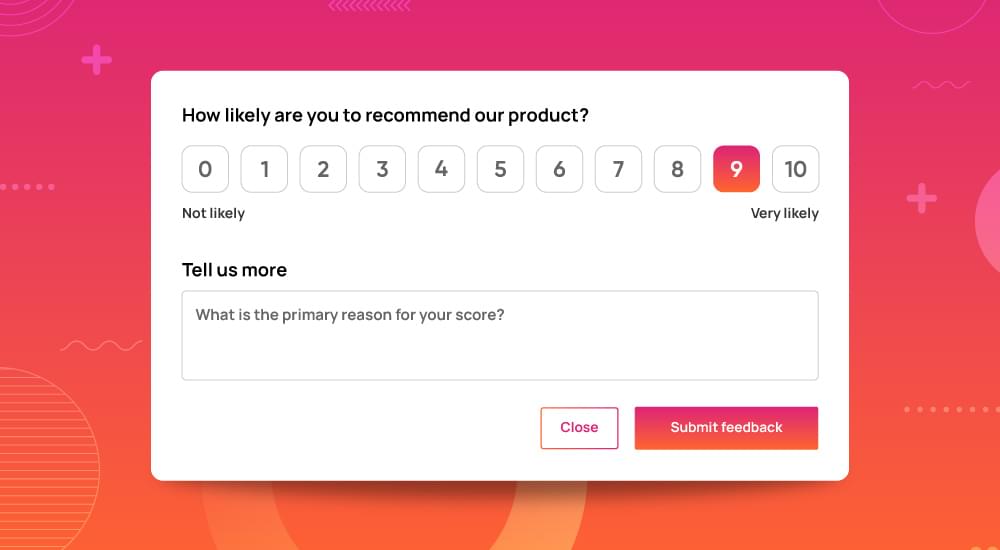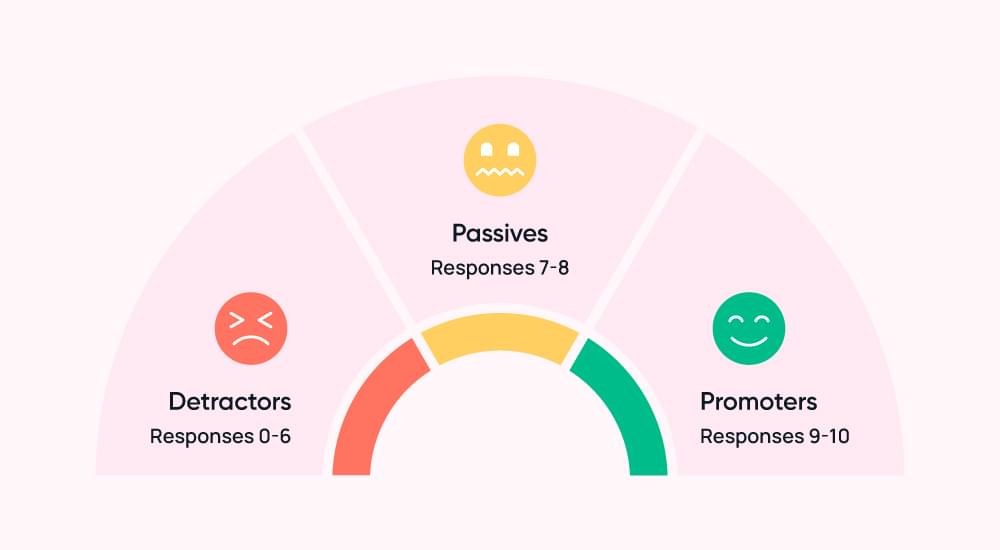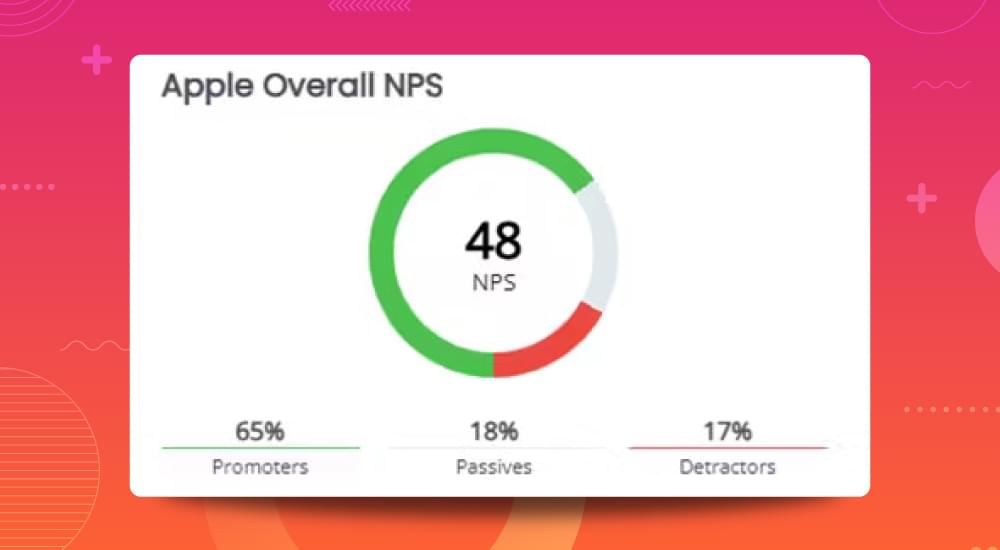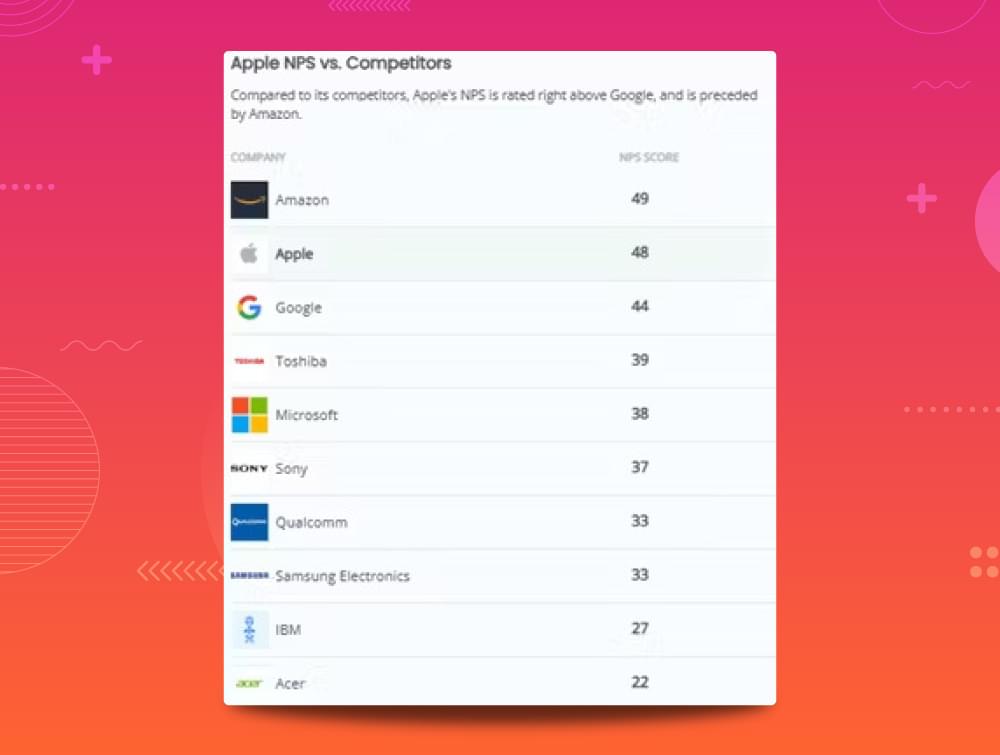
What is Net Promoter Score? Understand NPS the easy way

Let’s understand what is net promoter score the easy way. You will agree with the fact that when we enjoy watching a movie, we most likely remember it for a long time. Whenever asked, we recommend others to watch it too.
This referral we just gave out to the movie is the Net Promoter Score (NPS) for its business. This is what every business dreams of—to have customers who are so in love with their overall experience of your business that they cannot help but suggest it to others.
But how do companies know if customers feel this way? That’s where the Net Promoter Score (NPS) comes in.
“NPS is the ultimate pulse meter of your business.”
Moving on, we will understand how you can calculate NPS for your business and why you should care about your score. We will also discuss the NPS case study of Apple.
Let’s get started!
What is Net Promoter Score
Net Promoter Score (NPS) gauges the likelihood that customers will refer your product, service or business to others.
NPS was developed by Bain & Co. in 2003. It depicts customer loyalty in numbers. The NPS metric is based on one simple question:
Related Read: What is the most direct cause of customer loyalty
“On a scale from 0 to 10: How likely are you to recommend our company/product/service to a friend or colleague?”

Depending on their responses, we place them into three categories:

Promoters (Score 9-10): These are loyal enthusiasts who will continue buying from your company and actively recommend you to others.
Passives (Score 7-8): Satisfied but not enthusiastic customers. They could easily switch to a competitor if a better offer comes along.
Detractors (Score 0-6): Unhappy customers who could damage your brand through negative word-of-mouth or leave your business altogether.
Net promoter score means customers loyalty in numbers. It is the easiest and most genuine way of gauging client satisfaction and word-of-mouth referrals. But it’s not just a number.

How to Calculate Net Promoter Score (NPS) for Your Company?
Here’s a step-by-step guide to net promoter score calculation for your company.
1. Conduct NPS Surveys
Carefully segment your customer base for Net Promoter Score survey and NPS questions. Be mindful of when and how you will conduct the survey. Once clarified, share your NPS surveys with your customers. These surveys usually ask just one question: “On a scale of 0-10, How willing are you to recommend our company/product/service to a friend or colleague?”
Classify the responses received and categorize customers as Promoters (scoring 9-10), Passives (scoring 7-8), or Detractors (scoring 0-6).
2. Calculate Net Promoter Score:
Once you’ve collected responses, calculate the NPS. Subtract the percentage of Detractors from the percentage of Promoters.
% Promoters - % Detractors = NPS

The result is your Net Promoter Score and it ranges from -100, if every customer is a Detractor to +100, if every customer is a Promoter. Positive NPS score starts from 0. Scores above 50 are considered Excellent, and scores exceeding 80 are World-Class scores.
For example, if 50% of respondents are Promoters and 20% are Detractors, your NPS is:
NPS = 50% - 20% = 30
| Customer Group | Score Range | Percentage of Customers | NPS |
|---|---|---|---|
| Promoter | 9 – 10 | 50% | +50 |
| Passive | 7 – 8 | 30% | 0 |
| Detractors | 0 – 6 | 20% | -20 |
| Net Promoter Score | 30 |
A positive NPS means more of your customers are promoting your brand than detracting from it. This is a healthy sign of growth. But a negative NPS means you may have significant issues with customer satisfaction and loyalty.
3. Learn, Change, and Win
Examine the customer reviews and take note of any remarks and recommendations. Determine what needs to be improved and then create plans of action to address the matter. It is suggested that you talk to both happy and dissatisfied clients to learn about their points of view and their experience with your company.
4. Conduct regular NPS Surveys
Closely observe the trend of your NPS to record changes. Conducting regular customer surveys allows you to see the success of your campaigns on a regular basis.
5. Use tools to automate NPS
Opt to use an NPS Survey Platform. The tools will facilitate you to create powerful Net Promoter Score Surveys. And it will also help you distribute and analyze surveys among your customers more effectively.
How to Improve Net Promoter Score
Let’s explore some actionable tips for raising your NPS score so that you can compete better within your industry.
Close the loop with customers
This is what every large organization does – they close the loop with customers once they receive feedback.
It does not only mean that an email is sent to the customer saying that you have recorded their feedback. It has to mean that you also reach out to them via different modes of communication like phone calls, SMS etc.
Recommended Read: Personalized Communication
This approach is even better to adopt when there are more passives and detractors in the NPS. When the customer rating falls below 8, try to gather as much information in the survey as possible. Then, get in touch with each one of them personally. When they feel that they have been heard, they might consider a change of mind and eventually turn into a loyal customer.
Build Customer Centric Net Promoter System Across the board
Developing a culture always comes from the management. Give customer centric vision to your teams and train them accordingly. Brainstorming sessions can bring results along with other efforts. Reichheld refers to these quick meetings of 15 – 30 minutes as “huddles”.
Every team member should know how your company’s NPS system works as well as how the results are calculated and interpreted. Train them on how they can work individually and collectively to improve these scores.
Keep your focus on prioritizing and benefiting the promoters with referral programs. For detractors, create strategies like customer retention management so that they can be converted to at least passives.
Recommended Read: Retention Marketing
Monitor Departmental NPS and make required changes.
Data and findings received from NPS analysis surface not only customer pain points but also highlight the weaknesses in the processes that run our departments or the products or services we offer. This way, you can identify which department or product has more detractors than the promoters. It might not only be a department or a product but the customer journey that’s leading to lower NPS scores than average.
Therefore, the findings might require you to change the company policy, processes, ways of communication, and even its structure. This could be a serious concern at times and require your time and money. Check the NPS again to see if the modifications have been helpful or not.
Recommended Read: NPS Benchmarks
Don’t Stop - Grow More
Once you have improved NPS and achieved specific benchmarks across the board – don’t stop working to improve and grow. Stay connected to your happy customers, engage them with referral programs and discounts – put them to acquire new customers.
Why is Net Promoter Score Important in 2024
As we go through 2024, the importance of NPS continues to grow. NPS provides priceless insight into customer satisfaction—a major and legit indicator of organic growth and long-term success of an organization. It helps attract better workforce and more investors.
Here’s why you should calculate NPS & work to improve it:
Now that businesses really understand the importance of customer satisfaction with Customer is the King mindset, the net promoter score gives you a clear view of whether your business really works with this mindset and how well your company is meeting customer expectations.
Since NPS has a substantial correlation with business growth, it holds a predictive power about the organic growth of your company. More promoters mean more referrals.
Many companies now use Employee Net Promoter Score (eNPS) to gauge employee satisfaction since they realize that happy employees make happy customers.
Apple: A Case Study for NPS for Customer Loyalty
Apple’s NPS case study has influenced many businesses in its industry. Apple, which is now famous for its strong brand loyalty has once faced many challenges. Historically, Apple has been criticized for prioritizing innovation over directly listening to customers. Despite Steve Jobs’ famous stance that focus groups were not central to Apple’s product development, Apple still needed a mechanism to align product improvements with customer expectations.
To cope with this criticism, they needed Consistent Customer Feedback and Rapid Response to Customer Issues. Apple responded to both of these needs by implementing NPS in their customer services.
Results
From 2007 to 2017, Apple’s NPS score went up from 58 to 72 confirming the fact that people really like the brand and its products and the fact that Apple’s efforts to keep improving its NPS were paying off well.
Apple’s NPS dropped to 61 at the start of 2023; meanwhile, Apple’s Airpods scored an NPS of 75, which is exceptional. The average Net Promoter score of technology sector is 59 whereas Apple’s stands at 61 which is above average.
The NPS further decreased to 48 till Dec 2023, still being the 2nd brand choice among Gen-Z with 65% Promoters, 18% Passives, and 17% Detractors. 2


How has Apple Implemented NPS
Apple’s impressive Net Promoter Score (NPS) results from different efforts done by the company over the years. Here’s where it stands in the industry. 3

- Customer First Approach and Outstanding Customer Support at Retail Stores
Apple focuses on creating apps and gadgets according to customer preferences and keeps on working to improve customer experience in its every product.
This commitment to customer satisfaction is noticeable in Apple stores, where store managers and staff members are trained to connect with customers personally. The staff is trained to guide the customers through a five-step process to bring joy and inspiration.
Apple uses NPS extensively in its retail stores, gathering feedback from customers after they interact with store staff or make a purchase. Surveys are sent shortly after a customer visit to capture immediate feedback about their experience.
- Customer Support
Apple also tracks NPS through its customer support channels, including phone support and Genius Bar appointment options. After a support interaction, customers receive an NPS survey to evaluate how likely they are to recommend Apple services to others.
- Promoting Employee Satisfaction
The reason behind Apple’s strong net promoter score is its workforce. Apple uses surveys like the employee Net Promoter Score (eNPS) to measure how content and involved employees are. It creates an atmosphere of trust and teamwork. Satisfied employees tend to feel empowered; they’re more likely to provide great customer service that aligns with the brand’s values, ultimately boosting customer satisfaction.
Apple has shown strong dedication to making customers happy and keeps on innovating new products and apps. These factors explain why Apple consistently stands out as one of the leading brands of loyal customers.
Technology in NPS and the Future of Customer Experience Management
In 2024, you cannot deny the power of technology for NPS management – as it is not just an option anymore.
Modern technology and trends are changing the process of NPS as we speak. AI and Machine Learning soon will help predict NPS scores and suggest response strategies. Continuous feedback collection and analysis will replace periodic surveys, and real-time NPS scores will be available. Similarly, NPS data will be increasingly combined with other data sources for better insights. Some even suggest NPS will evolve beyond numerical scores to include analysis of customer comments and tone.
Closing note: Find the Secret to Great NPS
The secret to scoring a great NPS is – your business committing to create remarkable customer experiences for its customers EVERY SINGLE TIME.
There is no other secret to it but this.
Here are some more related guides to measure benchmarks like net promoter score.



